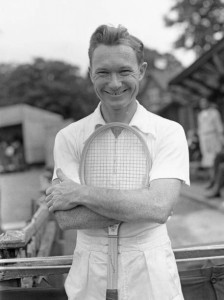by Randy Walker
@TennisPublisher
There was a feature on Tennis Channel and Tennis.com that counted down the top 10 “Biggest Hot Heads In Tennis.” As with many of these polls and rankings, mainly recent players are featured, while many players prior to the 1980s are not mentioned.
One “hot head” not featured was Cliff Richey, whose nick-name was “Bull” because of his temperament was about as subtle as a bull. A once-famous – now forgotten – episode involving Richey and his temper came at the Washington, D.C. tournament when, disputing the condition of the clay court, actually ripped up the nailed-down baseline strip of the court. Richey discusses this – and other on and off-court incidents – in his memoir “Acing Depression: The Tennis Champion’s Toughest Match.”
Before Richey, there was Dennis Ralston, who was so ill-tempered that his nick-name was “Dennis the Menace” and was once suspended from the 1961 U.S. Nationals at Forest Hills.
However, perhaps the biggest hot head that was overlooked in the poll was the only player who was banned for life from tennis due to his temper.
His name was Earl Cochell and he, like Ralston, was a former member of the University of Southern California men’s tennis team. Cochell actually received a life-time ban from tennis due mainly to an incident at the 1951 U.S. Nationals against Garnar Mulloy. Mark Young features Cochell in his book on ”Trojan Tennis Trojan Tennis: A History of the Storied Men’s Tennis Program at the University of Southern California” (for sale here: https://www.amazon.com/dp/1937559823/ref=cm_sw_r_tw_dp_U_x_fTOhCbTHFW8JX) and describes the incident description as follows:
A passionate competitor, Cochell was known to have a fierce temper. During a Round of 16 match at the U.S. Championships in 1951 against Gardnar Mulloy, Cochell, after splitting the first two sets, but down 4-1 in the third, decided to throw that set and save his energy to come out strong in the fourth set. When it became obvious to the crowd that he was throwing the set (he began to serve underhanded), they started to boo and heckle him. Cochell began to yell back. The chair umpire asked Cochell to “play tennis,” at which point he attempted to climb the umpire’s chair to grab the microphone. Cochell was pulled back before he could get the mike. At one point he hoisted his racket to the crowd as an extension of his middle finger.
After he lost the fourth set to Mulloy, he confronted refer Ellsworth Davenport and used such abusive language that the U.S. Lawn Tennis Association (now the USTA) banned him from tennis for life. To this day he holds the distinction of being the only tennis player to have ever been sanctioned for life by the USTA. In 1962, he was reinstated, but by that point he was no longer competitive.
Cochell’s teammate (Don) Eisenberg was surprised by the news about him when the news of his famous tantrum came out. “In 1951, I played Ed in a Palm Springs tournament and I won the first set and had a chance in the second. He could have gone off and shown his temper then but I don’t recall anything. I do remember that he was a character, would clown around a lot and had a good sense of humor. He would also would sing opera while he was walking between classes. After the Forest Hills incident, I never heard from him again.”
“Trojan Tennis: A History of the Storied Men’s Tennis Program at the University of Southern California” by USC men’s tennis historian and Marshall School of Business professor S. Mark Young, is the first-ever book about a college tennis program. Published by New Chapter Press, “Trojan Tennis” documents the most successful college tennis program, dating from 1899 through the end of the 2016-17 season. USC tennis legends Stan Smith and Stevie Johnson both contributed forewords to the hardcover book that features interviews with many of the program’s greatest players also including Alex Olmedo, Dennis Ralston, Bob Lutz, Rick Leach, Luke Jensen as well as legendary coaches George Toley, Dick Leach and Peter Smith. While the progress of the team is central, readers will be fascinated by the biographical details of the key figures in each time period, which are enhanced by extensive footnotes drawing from archival materials, including personal letters, scrapbooks, published news stories, and original interviews.
“We are so lucky Dr. Mark Young found us,” said Peter Smith, the USC men’s tennis coach. “He had a dream to write the story of the USC men’s tennis team. Little did any of us know what a the grand that lay ahead of him. Mark looked into every detail and every character – the story is a great read. He is the perfect person to tell our story and we can’t wait to share it with the world.”

